This post may contain affiliate links. Please see our disclosure policy.
Pickled dilly beans are a real treat, and many would argue that they’re much better than regular pickled cucumbers. Make dill pickled green beans at home and find out for yourself!
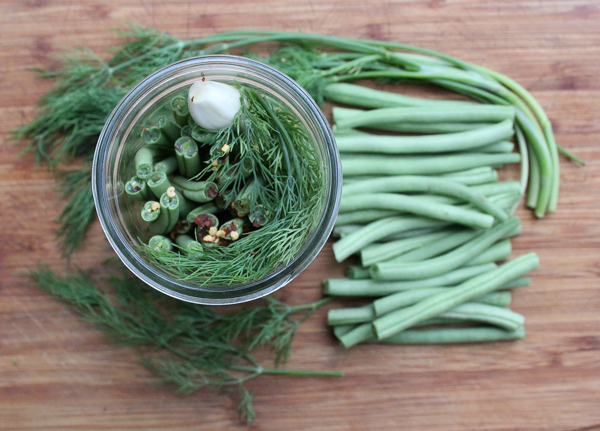
Table of Contents
My first dilly beans were given to me by a true native Vermonter. I mean ancestors back to the Abenaki old school Vermonter. Beard so big you couldn’t see his chest, mountain man Vermonter.
And here he was saying to me, “You gotta be kidding me girl. You ain’t never had dilly beans before? What’s wrong with your girl? You don’t know NOTHIN’ about good food.”
He went inside to get some of his mama’s old-fashioned dilly beans, because if there’s one good thing about green beens it’s they’re prolific, so there’s always spare to be handed out to a flatlander that needs an education on good food.
I’ll admit, I was downright knock your socks off impressed.
I make a pretty spectacular pickle, but I could eat dilly beans all day long and never miss a pickle. The texture is crisp and firm, and there’s something about a green bean that absorbs and complements dill better than any pickle I’ve ever had.
A bit of garlic and a hint of spice from red pepper flakes, and you’ve got yourself a well-rounded taste that’s hard to put down.
When I asked for the recipe, I was told that “mama don’t need no recipe for them dilly beans.” But I got rough proportions and an idea, and went looking on my own.
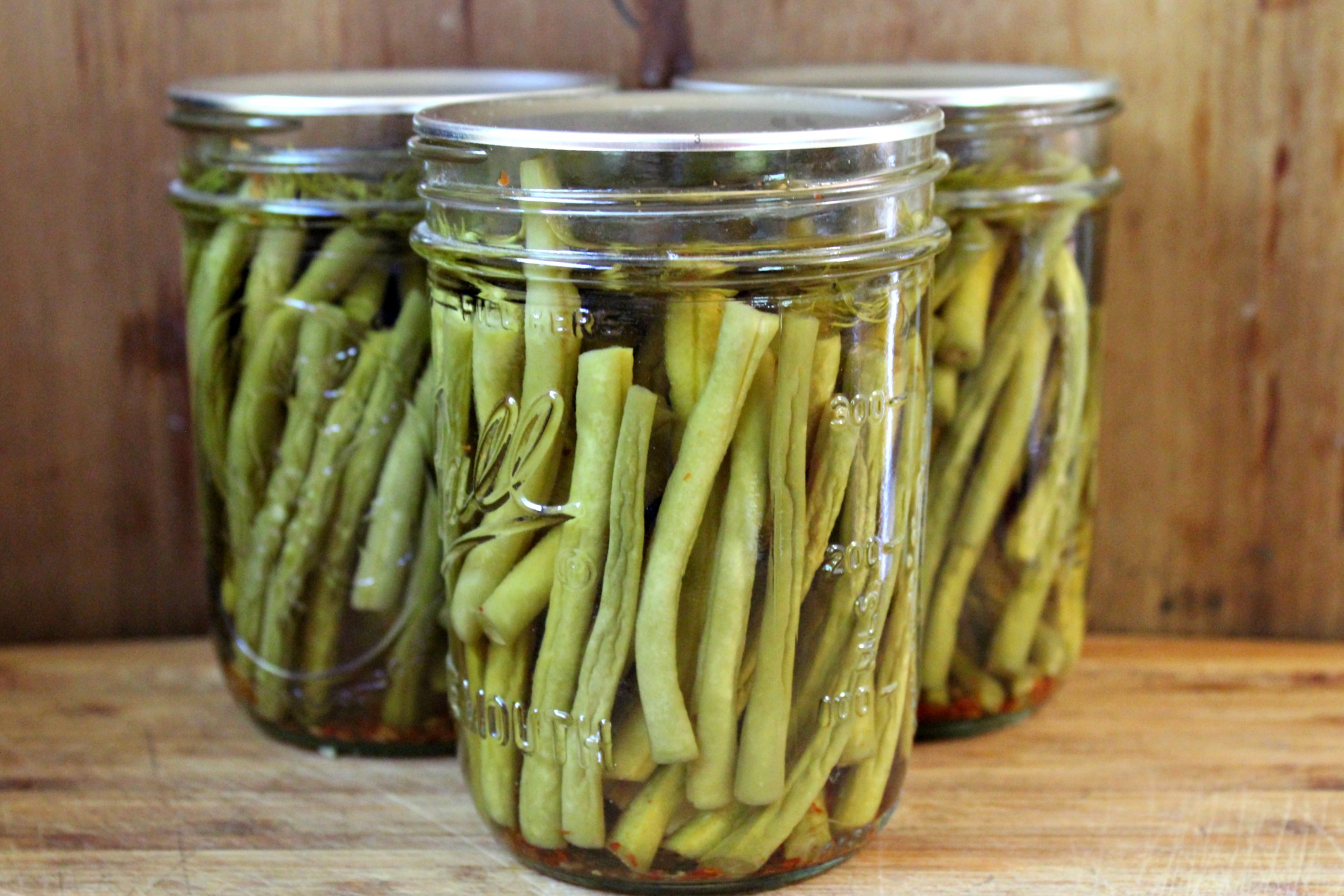
After trying a number, I settled on this downright perfect recipe from The All New Ball Book of Canning and Preserving.
It’s a good approximation of my first dilly bean. Try it and let me know what you think.
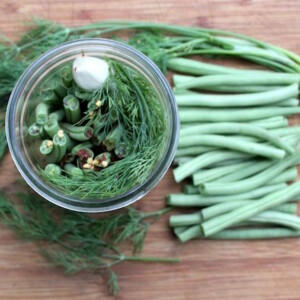
Pickled Dilly Beans (Dill Pickled Green Beans)
Ingredients
- 2 lbs. green beans, ends trimmed
- 2.5 cups vinegar, 5% acidity
- 1 cup water
- 3 tbsp canning salt
- 3/4 tsp crushed red pepper flakes
- 6 fresh dill sprigs
- 3-6 garlic cloves, peeled
Instructions
- Wash beans and trim the stem ends. Trim both ends if you like uniformity, but the tail end is the tender end so you can leave it intact. I start by measuring one bean to 1 inch below jar height, and then cut them all to the same length so they pack well into the jar.
- Pack the green beans into wide mouth pint jars and top each jar with 1/4 tsp. red pepper flakes, 2 dill sprigs and 1-2 garlic cloves. Be sure to leave just over 1/2 inch headspace.
- Combine vinegar, water and canning salt and bring to a boil on the stove to make a hot brine. Pour the hot brine over the beans in jars, leaving 1/2 inch headspace.
- Seal the jars with new canning lids, tighten on bands, and process in a water bath canner for 10 minutes, or 15 minutes if above 6,000 feet in elevation.
- Remove the jars from the canner and allow to stand at room temperature for a few hours until they've "popped" and completely sealed. Store any unsealed jars in the fridge and use immediately.
- For sealed jars, remove the canning bands and store in the pantry at room temperature.
Nutrition
Nutrition information is automatically calculated, so should only be used as an approximation.
Pickling Recipes
Looking for more homemade pickle recipes?
Personally, I think these are wonderful with Pickled Onions, either eaten together as a side dish or on top of a salad. They’re also great at potluck gatherings alongside other classic pickling recipes, including Bread and Butter Pickles, Dill Pickles and Southern Chow Chow.
If you’re looking for another pickled bean dish, try making pickled three bean salad. It has green beans included, but also shelled beans and a lemony kick, making it a great side dish.
If you’re looking for something a little wild, try making pickled fiddlehead ferns. They’re also a northern staple, and pretty darn similar to dilly beans, but they’re made with wild foraged fiddlehead ferns each spring.
While these are a northern staple, especially here in Vermont, dishes like pickled green tomatoes are equally well appreciated in the south.
What are your favorite regional pickling recipes? Leave me a note in the comments!
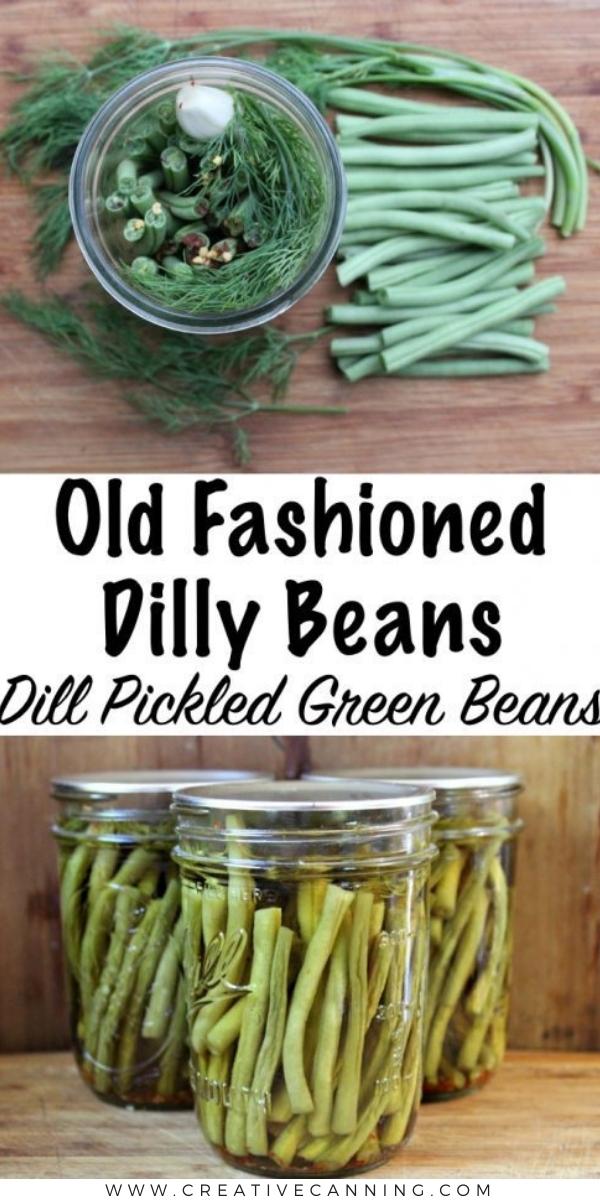
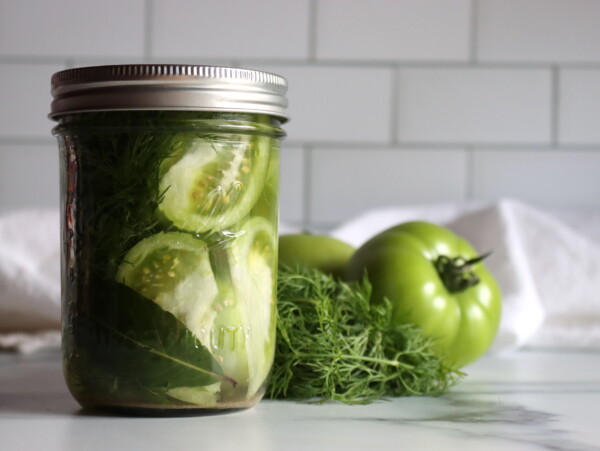
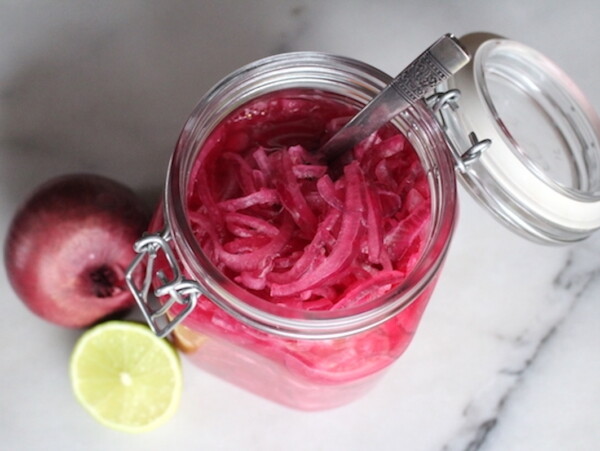
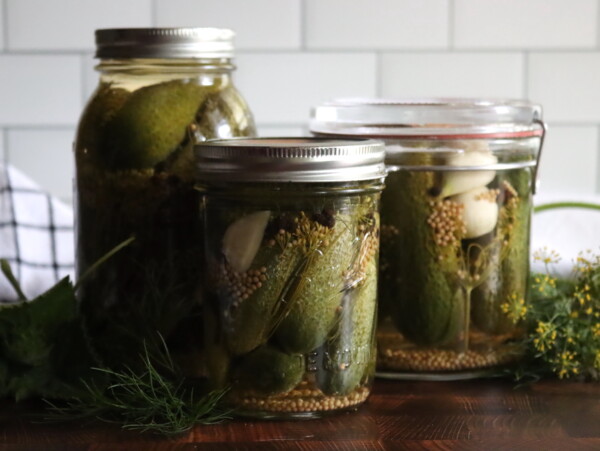
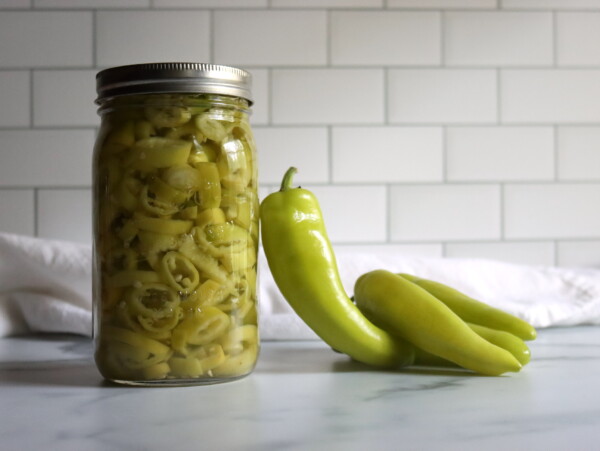
If I don’t have a canning pot will any large pot with a lid work? I have a large soup pot?
Yup, that works just fine. You don’t need a “canner” just a big pot that’s deep enough so that you can get the jars covered and submerged by at least 1 inch.
These were so yummy!! fairly simple to can, too. Thanks for the great recipe!!:)
You’re quite welcome! So glad you enjoyed them =)
All the other dilly bean recipes I’ve seen use equal parts vinegar and water. Does this recipe come out super vinagery?
When pickling, you can use up to half water in the recipe (but no more). The minimum amount for safe preservation is at least half vinegar, but you can use more. This particular recipe was developed by Ball Canning to mimic the type of dilly beans that are popular in the northeast, where people tend to like them with a bit more punch. If you don’t want them to be quite so intense, you can use half water. You can also add a bit of sugar for balance too. Either are fine adjustments.
I love garlic but my body doesn’t. If i don’t use garlic would this change anything about the safety? Do you have any safe suggestions for substitutions that would give a that garlic flavour?
You don’t have to use garlic, feel free to skip it. For a kind of similar flavor, you could try onions or shallots, which are both fine in this recipe. A bit of horseradish or black peppercorns are also good substitutions. Hope this helps!
I made this recipe 2 weeks ago and did the sound test on the lid. Some do not sound high pitch. They have a full sound. The jar looks sealed and you can not press the middle of the lid down. I have them stored in my cold room. My question is how do I know if they are a proper seal and what do I do if it isn’t sealed properly? Can I put them in the fridge to eat right away or should the be tossed?
If the jars are sealed, you should be able to remove the rings and then carefully pick the jars up by the lids with the tips of your fingers. The lid should stay attached even with the weight of the jar. (Obviously, do this carefully, you don’t need to lift it more than 1/2 inch off the counter). First test to make sure the center of the lid stays down, which it sounds like it did, but then you can remove the rings and do this second test. Best of luck!
Hi! I am thinking of buying a pressure canner and wonder whether I can use it for pickled recipes like this one? One of the websites says that pressure canner can not be used for high acidic foods like pickles
Yes, you can definitely use it for pickles. On many recipes there are actually pressure canning and water bath canning recipes right next to each other, mostly high acid fruit canning recipes. That said, what I’d do is use the pressure canner as a water bath canner. Just put the bottom trivet in it and then fill it up with water, and use it just like a water bath canner (don’t put the pressure canning lid on). Pressure canners are versatile that way, they can be used as water bath canners without the lid or as pressure canners with the lid.
You can pressure can low acid recipes if you want, that’s fine, it’s just overkill. It doesn’t harm things like fruit for the most part (ie. canning peaches or apple slices), just makes them a bit softer. For pickles, it’d really cook them to a squishy texture, and I wouldn’t recommend actually pressure canning them with the lid on. Water bath canning them in a pressure canner is really exactly the same was water bath canning in any pot though, and works just fine.
Does that make sense?
Thanks for answer the question about pressure canning. I was hoping to find a more fuel efficient way to pickle cauliflower and green beans, but I don’t want mushy veggies. Water bath is so energy intensive compared to pressure canning. I may give it a try anyhow and see how it turns out.
I made these last year and they were very good. I was jjust wondering if you could use yellow beans, something I have lots of these. Thanks.
Yellow beans should work just fine. Let us know if you decide to try it.
Would this work well for pickled carrots?
Yes, I definitely think this recipe would work well for carrots as well.
I would like to try the dilled green beans recipe but can not find a button to print it. I don’t like to use my phone while cooking (gross!). Is there a place I can find a printable copy of your recioe?
You could simply copy and paste the recipe into a blank document and print it that way.
Can I use quart jars for these? (Read your tip on sticking with pints for the pickles.) I have SO many beans.
Everything that I have read says that it is not recommended to use quart jars, only pints.
Can I use the same brine as the dill pickles for these dilly beans???
Of course!
I used this brine to can cauliflower and carrots. I only had quart jars left. I water bathed them for 30 minutes. Do you think they will be shelf stable or should I just refrigerate them?
You might want to just refrigerate them. All of the information that I am seeing says to use pint jars and that quart jars are not recommended.
I’ve looked at a lot of recipes and most all of them are using pint jars. Is there a reason? It seams like a quart jar would be easier, you wouldn’t have to trim the bean. I feel like I’m wasting a lot by cutting so much of the bean off.
I have read that in a lot of different places as well but I can’t find anywhere that says why.
hello- I just finished making them! How long do they need to sit before using them?? thanks 🙂
4-6 weeks is plenty of time!
Do you heat the jars before putting the beans in them?
Yes, you should clean and sterilize your jars and then keep them warm before filling them.
Do these stay crisp like a pickle or do they tend to mush a bit?
They stay crisp, they do not get mushy at all.
Hello! I just finished pulling these out of the water bath, and I can’t WAIT to try them! How long do the green beans need to sit in the juice before they have the flavor of being pickled? I’d like to open one asap. Thanks!
At least a week, preferably at least 2 weeks.
I can’t find fresh dill in our little town. I can get dried at Walmart. I tried growing dill, but the house is too dark and it is too hot in Texas. Help! Can I use dried?
Yes! That’s happened to me a time or two as well. I don’t use the green dried dill tops in canning (mainly because it always smells like alfalfa from the stores around here, too old I think). I’ve just substituted a good amount of dill seed instead of the fresh dill and they come out great. Smell the dill seed and make sure it has a good strong smell to it, it loses potency quick and old stuff (even a year old) doesn’t taste like much.
Do you serve these beans cold, like a pickle or do you warm them? We like to add vinegar to our cooked fresh green beans.
Cold like a pickle is the way we eat them, honestly I never thought to serve them warm like a side dish. Now I wonder…it might work?
Hi there. I’m looking at this recipe because we’re just starting to see crops of fresh green beans in our area. I was wondering what the shelf life on these were, when you store them
I’ve had them on the shelf for 12-18 months in my pantry without issues.
Hello- I canned the dilly beans a few weeks back. I followed the recipe exactly; however, they taste very bitter. I can’t quite put my finger on what is missing. Could you please weigh in with your thoughts on what I’ve done wrong? Thank you, Sarah
My first thought was that maybe the green beans were a bit too old? They get a little bitter if they’re left on the plant too long, and that’ll really come through if they’re canned. The seeds inside should still be very small, tiny little specs. Even if picked on time, they’ll still get a bit bitter if they’re in the fridge too long waiting to be canned (or on the grocery store shelf too long).
If that doesn’t sound like the issue, I did a bit of research and here’s what the ball canning website has to say about bitter pickled vegetables:
“This happens when you use old spices, cook too long in vinegar, or you use too much spice. Use fresh spices – use whole spices within 3-4 years of purchase. Use the processing time and method recommended in the tested fresh preserving recipe. You may have used vinegar that was too strong. Always use vinegar with 5% acidity for fresh preserving. Using a salt substitute in place of Salt for Pickling & Preserving could be the problem. Salt substitutes contain potassium chloride, which is naturally bitter.” (source: https://www.freshpreserving.com/pickles-problem-solver.html)
I hope this helps!
I’d also add in that table salt contains iodine, which is bitter.
We just tossed out three pints of these dilly beans. Followed this recipe to a tee also! They were were simply awful!!! Fresh beans right out of the garden the day of canning. The vinegar was SO overpowering making it bitter and using crushed peppers in this recipe, left a burning sensation on your tongue that lasted for hours. I DO NOT recommend making this recipe unless you enjoy throwing out good food or burning a hole in your stomach!!!. Stick to original BALL recipes for Dilly Beans and you’ll be fine.
Home canned dill green beans were something my mother was especially good at canning. We grew up on her home canned pickles, dill green beans, fruits and veggies. This makes me miss my childhood days but remember then fondly.
I’ve never tried pickling my own dilly beans before, this makes it sound so simple and straight forward! Thank you for sharing your recipe, I can’t wait to try it at home!